
Caladenia saccharata, commonly known as sugar orchid, is a species of flowering plant in the orchid family, Orchidaceae and is endemic to the south-west of Western Australia. It has a single leaf and a single flower with three white sepals and two similar petals.
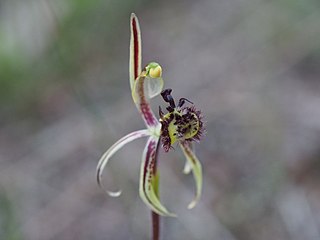
Caladenia barbarossa, commonly known as the common dragon orchid is a species of orchid endemic to the south-west of Western Australia. It can be distinguished by its distinctive labellum which is attractive to species of male thynnid wasps.

Caladenia dundasiae, commonly known as the Patricia's spider orchid and Dundas spider orchid is a species of orchid endemic to a small area in the south-west of Western Australia. It is a rare orchid with a single hairy leaf and one or two, usually red flowers with thin, stiffly-held lateral sepals and petals.

Caladenia gardneri, commonly known as the cherry spider orchid, is a species of orchid endemic to the south-west of Western Australia. It has a single, hairy leaf and up to three pale pink, sweetly scented flowers with a dark pinkish-red labellum.

Caladenia georgei, commonly known as the tuart spider orchid, is a species of orchid endemic to the south-west of Western Australia. It has a single, hairy leaf and up to three whitish to yellowish-green flowers flushed with red and which have a white labellum with a red tip.
Caladenia hoffmanii, commonly known as Hoffman's spider orchid is a species of orchid endemic to the south-west of Western Australia. It has a single, hairy leaf and one or two, greenish-yellow, red and white flowers which have a greenish-yellow labellum with a red tip. It is distinguished from the Pingaring spider orchid by small differences in the labellum and more northerly distribution.
Caladenia incrassata, commonly known as the puppet clown orchid is a species of orchid endemic to the south-west of Western Australia. It has a single, hairy leaf and usually only one greenish-yellow and red flower which has a red-striped labellum.
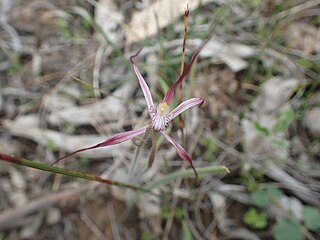
Caladenia occidentalis, commonly known as the ruby spider orchid, is a species of orchid endemic to the south-west of Western Australia. It has a single erect, hairy leaf and one or two pinkish-red flowers with a white, red-striped labellum.

Caladenia paradoxa, commonly known as the ironcaps spider orchid, is a species of orchid endemic to the south-west of Western Australia. It has a single erect, hairy leaf and up to three small creamy-white flowers. It was previously thought to be the same species as the eastern Australian Caladenia flaccida but is now recognised as distinct.
Caladenia postea, commonly known as the dark-tipped spider orchid, is a species of orchid endemic to the south-west of Western Australia. It has a single erect, hairy leaf and up to three small, pale creamy-white flowers. It has a relatively late flowering period compared to similar spider orchids.

Caladenia speciosa, commonly known as the sandplain white spider orchid, is a species of orchid endemic to the south-west of Western Australia. It has a single erect, hairy leaf and up to three relatively large white flowers tinged with pink and with a fringe of long teeth on the sides of the labellum.
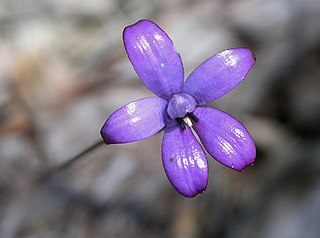
Elythranthera brunonis, commonly known as the purple enamel orchid, is a plant in the orchid family Orchidaceae and is endemic to the south-west of Western Australia. It is a ground orchid with a single flattened, hairy leaf and up to three glossy purple flowers.
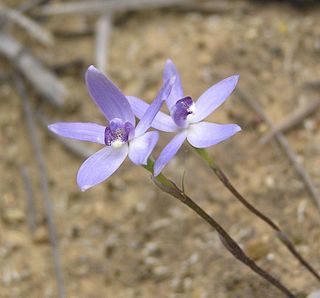
Cyanicula amplexans, commonly known as the dainty blue china orchid, is a plant in the orchid family Orchidaceae and is endemic to Western Australia. It has a relatively broad leaf and one or two pale blue and white flowers. It is distinguished from the other two similar blue orchids by the sides of the labellum which curve over the column and almost touch. This species also has a more inland distribution than C. aperta and C. sericea.
Cyanicula ashbyae, commonly known as the powder-blue china orchid, is a plant in the orchid family Orchidaceae and is endemic to Western Australia. It has a relatively short, broad leaf and one or two pale bluish-mauve flowers.
Cyanicula fragrans, commonly known as the fragrant china orchid, is a plant in the orchid family Orchidaceae and is endemic to Western Australia. It is similar to the other china orchids, especially C. ashbyae but has a paler green leaf, vanilla-scented flowers and a more northerly distribution.

Cyanicula gemmata, commonly known as the blue china orchid, is a plant in the orchid family Orchidaceae and is endemic to the south-west of Western Australia. It has a small, oval leaf and up to three intense blue to mauve flowers. It is the most common and widespread of the West Australian china orchids, sometimes appearing in large numbers after summer fires.
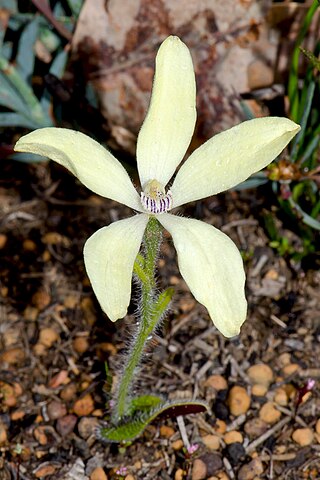
Cyanicula ixioides, commonly known as the white china orchid, is a plant in the orchid family Orchidaceae and is endemic to the south-west of Western Australia. It has a single, broad, flattened leaf and up to three yellow or white flowers. It mostly only occurs in woodlands and forest near Perth.
Cyanicula gertrudae, commonly known as the pale china orchid, is a plant in the orchid family Orchidaceae and is endemic to the south-west of Western Australia. It has a small, oval leaf and one or two pale blue, sweetly-scented flowers. It is similar to Caladenia gemmata but its leaf is green on both surfaces, the flower is scented and the labellum is striped.

Caladenia sericea, commonly known as the silky blue orchid, is a plant in the orchid family Orchidaceae and is endemic to the south-west of Western Australia. It is a common orchid in the high rainfall areas of the state and has a single, broad, silky leaf and up to four blue-mauve flowers.
Caladenia nikulinskyae, commonly known as Philippa's china orchid, granite china orchid and Esperance china orchid is a plant in the orchid family Orchidaceae and is endemic to the south-west of Western Australia. It is very similar to Caladenia gemmata but has slightly smaller flowers with taller calli. It has a single broad, flattened leaf and up to two pale blue flowers and occurs near Esperance.













